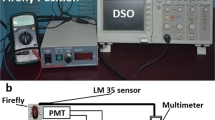Summary
The restrained male of the fireflyPteroptyx cribellata of Papua New Guinea responds to exogenous light signals with a latency of about one second, which equals the period of the natural spontaneous rhythm of flashing and includes about 800 ms of central nervous delay. The response is cycle-by-cycle and all-or-none and the duration of the response time is independent of the phasing of the driver in relation to the free run rhythm (Figs. 1, 2). The firefly can be entrained to rhythms over a period range of 800 ms to 1,600 ms, during which it leads or lags the concurrent signal by an amount equal to the difference between the driving period and the animal's period (Figs. 3, 4). The phase-response line is nearly straight and is inclined 45 ° (Figs. 2, 5). Normally an exogenous signal dictates interflash timing but occasionally may fail to entrain the firefly (Figs. 7B, E) or may fail to evoke a flash (Figs. 7F, G). Persistence of endogenous control of timing period duration even during driving is occasionally seen as spontaneous drift in response time (Fig. 9). It is proposed that during entrainment each exogenous signal resets the pacemaker immediately to the start of its endogenous cycle, from which point it then begins a new series of free run periods. Thus each flash is timed in relation to the signal of the preceding cycle (Fig. 3). We devised a model of the endogenous timing cycle which fits the empirical data and achieves entrainment by a single mechanism involving phase advance or delay rather than change in actual rate of endogenous timing (Fig. 12). The proposed mechanism by which single males entrain to light signals seems compatible also with the mass synchronous flashing which is the characteristic behavior of field congregations.
Similar content being viewed by others
References
Bagnoli P, Brunelli M, Magni F, Musameci D (1976) Neural mechanisms underlying spontaneous flashing and its modulation in the fireflyLuciola lusitanica. J Comp Physiol 108:133–156
Buck JB (1938) Synchronous rhythmic flashing of fireflies. Q Rev Biol 13:301–314
Buck J, Buck E (1968) Mechanism of rhythmic synchronous flashing of fireflies. Science 159:1319–1327
Buck J, Buck E (1976) Synchronous fireflies. Sci Am 234:74–85
Buck J, Buck E (1978) Toward a functional interpretation of synchronous flashing by fireflies. Am Nat 112:471–492
Buck J, Buck E, Hanson FE, Case JF, Mets L, Atta GJ (1981) Control of flashing in fireflies. IV. Free run pacemaking in a synchroniePteroptyx. J Comp Physiol 144:277–286
Carlson AD (1969) Neural control of firefly luminescence. Adv Insect Physiol 6:51–96
Case JF, Buck J (1963) Control of flashing in fireflies. II. Role of central nervous system. Biol Bull 125:234–250
Case JF, Strause LG (1978) Neurally controlled luminescent systems. In: Herring PJ (ed) Bioluminescence in action. Academic Press, London, pp 331–366
Hanson FE (1978) Comparative studies of firefly pacemakers. Fed Proc 37:2158–2164
Hanson FE, Case JF, Buck E, Buck J (1971) Synchrony and flash entrainment in a New Guinea firefly. Science 174:161–164
Lall AB, Chapman RM, Trouth CO, Hollaway JA (1980) Spectral mechanisms of the compound eye in the fireflyPhotinus pyralis (Coleoptera: Lampyridae). J Comp Physiol 135:21–27
Perkel DH, Schulman JH, Bullock TH, Moore GP, Segundo JP (1964) Pacemaker neurons: Effects of regularly spaced synaptic input. Science 145:61–63
Wever R (1965) Pendulum versus relaxation oscillation. In: Aschoff J (ed) Circadian clocks. North-Holland, Amsterdam, pp 74–83
Author information
Authors and Affiliations
Additional information
We are much indebted to Drs. D. Alkon, T.H. Bullock, A. Carlson, F. Dodge, J. Enright, H. Gainer, R. Josephson, H.M. Pinsker, C.L. Prosser, A. Winfree and the late K. Roeder for various information, suggestions and editorial assistance. We thank especially Dr. Laurens Mets for valuable insights. The research was made possible by grants GB8158 and GB8400 from the National Science Foundation to the Scripps Institution of Oceanography in support of the 1969 Alpha Helix Expedition to New Guinea. Supplementary support was received by J.B. from the American Philosophical Society (Penrose Fund grant 5017) and the National Geographic Society; by J.F.C. from ONR Contract N0014-69-A-022-8006 and from the University of California Faculty Research Fund; by F.E.H. from a Faculty Grant, University of Texas. Mrs. Betty Morris cheerfully endured the typing of endless drafts.
Rights and permissions
About this article
Cite this article
Buck, J., Buck, E., Case, J.F. et al. Control of flashing in fireflies. J. Comp. Physiol. 144, 287–298 (1981). https://doi.org/10.1007/BF00612560
Accepted:
Issue Date:
DOI: https://doi.org/10.1007/BF00612560




